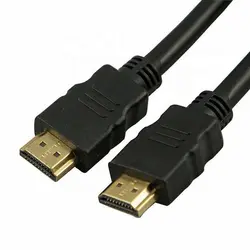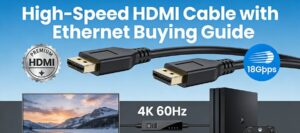1. Introduction
Background
High-Definition Multimedia Interface (HDMI) is a widely adopted standard for transmitting high-definition video and audio signals. HDMI connectors come in various types, including standard (Type A) and mini (Type C). Understanding the differences between these connectors is crucial for optimizing display performance and ensuring compatibility with various devices.
2. Technical Specifications
Overview of HDMI Technology
HDMI is a digital interface standard developed to transmit high-definition video and audio signals. Since its introduction, HDMI has evolved through several versions, each offering enhanced features and capabilities.
Types of HDMI Connectors
HDMI connectors come in several types, including:
- Type A (Standard HDMI): Commonly used in TVs, monitors, and AV receivers.
- Type C (Mini HDMI): Used in smaller devices such as digital cameras and camcorders.
- Type D (Micro HDMI): Used in even smaller devices such as smartphones and tablets.
3. Physical and Structural Characteristics
Standard HDMI Connectors
Standard HDMI connectors (Type A) are the most widely used and are designed to support high-definition video and audio transmission. They have 19 pins and are relatively larger compared to mini and micro HDMI connectors.
Mini HDMI Connectors
Mini HDMI connectors (Type C) are smaller than standard HDMI connectors but still support high-definition video and audio transmission. They also have 19 pins but are designed to fit into smaller devices such as digital cameras and camcorders.
Comparative Analysis
The primary difference between standard and mini HDMI connectors lies in their size and intended use. Standard HDMI connectors are used in larger devices such as TVs and monitors, while mini HDMI connectors are used in smaller, portable devices.
4. Data Transfer Rates and Bandwidth
Capabilities of Standard HDMI
Standard HDMI connectors support various HDMI versions, including HDMI 1.4, 2.0, and 2.1. These versions offer different data transfer rates and bandwidth capabilities:
- HDMI 1.4: Supports up to 10.2 Gbps, 4K resolution at 30Hz.
- HDMI 2.0: Supports up to 18 Gbps, 4K resolution at 60Hz.
- HDMI 2.1: Supports up to 48 Gbps, 8K resolution at 60Hz and 4K at 120Hz.
Capabilities of Mini HDMI
Mini HDMI connectors also support the same HDMI versions as standard HDMI connectors. Therefore, their data transfer rates and bandwidth capabilities are similar to those of standard HDMI connectors, depending on the HDMI version they support.
Comparative Analysis
There is no significant difference in data transfer rates and bandwidth capabilities between standard and mini HDMI connectors, as both support the same HDMI versions. The main difference is in their physical size and intended use.
5. Signal Integrity and Quality
Signal Transmission
Both standard and mini HDMI connectors use Transition-Minimized Differential Signaling (TMDS) to transmit high-quality video and audio signals. This method reduces the likelihood of signal degradation and ensures high-quality output.
Error Detection and Correction
Both standard and mini HDMI connectors include error detection and correction mechanisms to maintain signal integrity and ensure high-quality output.
Shielding and Interference
High-quality HDMI cables, whether standard or mini, are designed with shielding to protect against electromagnetic interference (EMI) and radio frequency interference (RFI), ensuring reliable signal transmission.
6. Compatibility and Interoperability
Device Compatibility with Standard HDMI
Standard HDMI connectors are widely compatible with various consumer electronics, including TVs, monitors, gaming consoles, and AV receivers. They support backward compatibility with older HDMI versions.
Device Compatibility with Mini HDMI
Mini HDMI connectors are compatible with smaller devices such as digital cameras, camcorders, and some tablets. They also support backward compatibility with older HDMI versions.
Interoperability
Both standard and mini HDMI connectors maintain interoperability with other HDMI devices through the use of adapters. This flexibility ensures that users can connect their devices regardless of the HDMI connector type.
7. Applications and Use Cases
Consumer Electronics
Standard HDMI connectors are widely used in consumer electronics for connecting TVs, monitors, gaming consoles, and AV receivers. Mini HDMI connectors are used in smaller, portable devices such as digital cameras and camcorders.
Professional and Industrial Applications
In professional and industrial settings, both standard and mini HDMI connectors are used for applications requiring high-resolution displays and reliable performance. Standard HDMI is more common in larger displays, while mini HDMI is used in portable equipment.
Emerging Technologies
Both standard and mini HDMI connectors are poised to play a significant role in emerging technologies, such as virtual reality (VR) and augmented reality (AR), where high-quality video and audio transmission is essential.
8. Power Management and Efficiency
Power Delivery in Standard HDMI
Standard HDMI cables do not provide significant power delivery capabilities, focusing primarily on signal transmission.
Power Delivery in Mini HDMI
Mini HDMI cables also do not provide significant power delivery capabilities, similar to standard HDMI cables.
Efficiency Improvements
Both standard and mini HDMI connectors benefit from ongoing advancements in HDMI technology, which continue to improve energy efficiency and performance.
9. Future Trends and Developments
Advancements in HDMI Technology
Future advancements in HDMI technology are expected to focus on increasing bandwidth, improving signal quality, and enhancing support for higher resolutions and refresh rates.
Market Adoption and Industry Trends
The adoption of both standard and mini HDMI connectors expect to continue growing, driven by the demand for high-quality display solutions in both consumer and professional markets.









